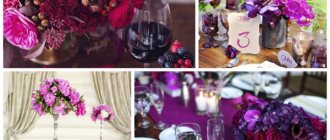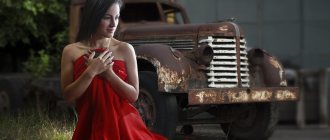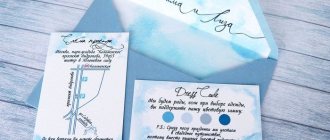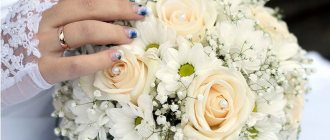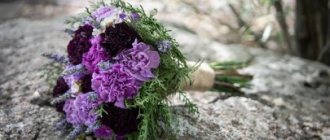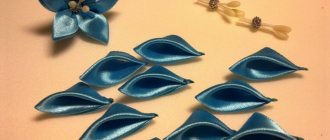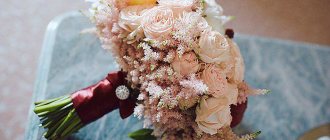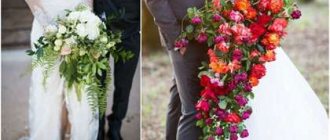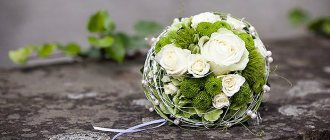How to do it yourself?
This question is quite complex, since the process largely depends on the plants available. Below are two options for compositions - based on summer meadow flowers (partially cultivated) and using ears of corn.
The first master class shows the spiral technique. In fact, the bouquet is collected from the middle, from the tallest plants. It is not necessary to arrange all the flowers sequentially - first some, then others, others... they can be alternated.
The basic principle: plants are gradually added to the initial two to five branches, gradually reducing the height of the composition and taking care that the flowers do not interfere with each other. The ends of the stems are trimmed after the final assembly and fastening of the branches.
Advantages and disadvantages
If you are faced with a choice of wedding arrangements, and you have not decided which bouquet is better, live or artificial, then let's look at their pros and cons. A properly created composition from non-natural materials can easily outshine any living one.
The advantage of artificial flowers is:
- perseverance;
- versatility;
- high quality;
- hypoallergenic;
- convenience;
- affordable price.
Fresh flowers are afraid of frost and direct sunlight. Non-living analogues are not susceptible to the vagaries of the weather. They are not afraid of lack of moisture, mechanical damage, or pollution.
This bouquet always looks fresh, clean and charming. Don't be afraid that the artificial one will look unnatural. If high-quality materials were used to make an artificial composition, then it will not differ from the natural one. Inanimate ensembles in photographs look much more advantageous than their natural counterparts. Therefore, the photo shoot will take place without any unpleasant surprises.
- Another advantage of an artificial bouquet is its high-quality decoration. All elements of jewelry are held firmly and reliably. And the flower petals will never wither from the glue that attaches the beads and rhinestones.
- Pollen very often causes allergic reactions. If the bride feels unwell from the rich aroma of fresh flowers or the groom has allergies, then an artificial floral ensemble is exactly what will not turn the holiday into torture.
- If suddenly an artificial accessory becomes dusty or dirty, it can be quickly restored to its proper form. It is easy to wash, dust can be removed with a sponge or brush.
- Fresh flowers are very difficult to match to a wedding dress. Any bouquet will go with a white outfit, but if the bride has chosen a rare shade of the dress, then inanimate elements will come to the rescue. Their widest color range will help you create a harmonious ensemble with precision down to the smallest tones.
A few words about comfort. Fresh flowers in a large composition weigh quite a lot. It won’t be easy for a newlywed to hold such an armful in her hands all day long. An artificial composition is much lighter. She will not cause the bride any discomfort. Also, the artificial bouquet will not be damaged when the girl gets in and out of the car.
Unnatural flowers have only one drawback: they have no smell. But this can be easily corrected by sprinkling the composition with your favorite perfume.
Symbolism of color
Yellow, along with red and blue, is the main color for florists when selecting various compositions. And none of the experts would call yellow flowers a symbol of betrayal or separation. On the contrary, this color personifies the warmth of personal relationships between two lovers, the sincerity and tenderness of mutual feelings, and also predicts successful and prosperous sailing in a joint boat called life for their future marriage.
After all, it all logically comes down to this:
- yellow color and its shades are close to the solar set, that is, to the light of heat;
- people are accustomed to lighting in houses and on the streets, and most of it also has a yellow tint (even in stores, the light of ordinary light bulbs is called “warm”);
- yellow color carries a positive charge, invigorates, improves mood, infuses vital energy and increases activity.
Types of the most beautiful cornflowers
The genus of these flowers includes up to 500 species (both annual and perennial), which decorate fields, meadows and gardens from early summer until September. In addition to the beautiful flowers with the characteristic blue color of the petals, there are also those that impress with white, yellow, purple and pink blooms.
Blue or field cornflowers
Greek myths say that these flowers healed the wise Chiron from the hydra bite. That is why cornflowers are called the “blue flower of the centaur.” These annual plants with characteristic turquoise inflorescences are one of the most beautiful representatives of the cornflower genus. But in agriculture, bright blue flowers in rye fields are considered weeds and are destroyed.
The length of the stem of field cornflowers can reach up to 80 cm. There are annual and perennial varieties, the turquoise colors of which create the illusion of the sky falling on fields, meadows and wastelands. Due to the characteristic color of the petals, field cornflowers are called blue flowers or hairs. These flowers were especially popular among the ancient Egyptians, who widely used the image of cornflowers when creating jewelry. Even in the tomb of Tutankhamun, the pharaoh’s funeral wreath of “blue flowers” was found.
Mountain cornflowers
These flowers can grow in the most difficult conditions, on almost any soil. They are found in the vast expanses of Central Asia and Western Europe. They can bloom in the usual blue color or have unusual purple and burgundy colors.
The colorful blooms of these cornflowers can be observed from late May to August.
White cornflowers
Many people associate cornflowers exclusively with the blue of the sky. But there are exceptions that are no less captivating with their extraordinary beauty. White cornflower is like an albino in a family of colorful brothers. This is a very rare species, which even ended up on the pages of the Red Book. The plant is also small in size - the stem of white cornflowers rarely exceeds 30 cm.
Large-headed cornflowers
These perennial plants impress with their longest stem (up to 1 m) and large flowers (up to 7 cm in diameter) of light or bright yellow color. The homeland of the species is the expanses of Transcaucasia. In gardens, such flowers are planted in flower beds in the background to create a beautiful background for other tall plants. These beautiful cornflowers bloom in mid-July and delight with their colorful blooms for 1.5 months.
Meadow cornflowers
This species is a true decoration of meadows and forest glades. In Slavic mythology, its appearance is associated with the anger of a mermaid, who turned a guy named Vasily, who refused her love, into a beautiful meadow flower. These plants are perennial, and their stem height reaches up to 80 cm. Meadow cornflowers impress with their unusual pink or purple color, and their flowers are collected in baskets.
Fisher's cornflower
This flower is endemic to the Caucasus, and in the wild it is found exclusively in the vast alpine meadows of this region. Its stems can reach up to 50 cm, and the flowers have a wide variety of colors. The inflorescences can be light pink, with a lilac or lemon tint and stand out beautifully among the alpine forbs.
Whitened cornflower
Due to the heterogeneity of color, this type of cornflower is considered one of the most beautiful among its “relatives”. Its flowers are bright pink, and its pinnately dissected leaves, which are white below and green above, give a special decorative appeal. The height of the plant can reach 60 cm. Its native growing areas are the mountains of the Caucasus and Northern Iran.
Pink cornflowers
These perennial plants up to 1 m in height fascinate with large single inflorescences of soft pink color.
It is this type of cornflower that is most often grown in gardens. Flowers delight with their colorful blooms from mid-summer.
Russian cornflower
These flowers with light yellow inflorescences decorate the steppe expanses of Russia and Kazakhstan in the summer. The bare stems of the plant can grow up to 50-140 cm. Growing in the wild in difficult conditions, this type of cornflower can withstand drought and is resistant to cold. In gardens, it most often plays the role of background in mixed flower beds.
Wedding hall decor in blue colors
Deep rich blue color always represents nobility, serenity and confidence.
A wedding in blue requires a careful approach - you need to think through every detail, from the dishes to the decoration of the hall. As a result, everything should harmonize with each other. Even though blue is a very beautiful color, there shouldn’t be too much of it. This may tire guests.
However, a small amount of blue is also bad - it will simply get lost and only the name will remain from the blue wedding. You need to find a balance in the design.
Drapery plays an important role in the design of the hall. Many people forget about this, and the banquet room does not look very festive. However, if you do everything right, even an ordinary dining room will sparkle with new colors. Blue fabric can be used to decorate not only the walls and entrance, but also the ceiling and floor.
Note! It is better to choose velvet material for tables. This will give the atmosphere royal grandeur and luxury.
You can add more festiveness and fun to the space with the help of balloons, large posters, various figures - this is a whole field for imagination.
If the blue wedding takes place in the winter, you can add New Year's themed elements to the decor, which will add even more fun and magic to the surrounding space. Christmas tree decorations, frosty patterns, snowflakes, and even Christmas candles are suitable here.
All this will resemble a wonderful, kind fairy tale, in which not only the heroes of the occasion, but also numerous guests will feel like heroes.
If a wedding celebration in blue takes place in the summer, elements of a nautical theme can be used in the decor. You can decorate the hall with corals, stones and shells.
Decor of tables and chairs in a blue wedding
Tablecloths with a combination of white and blue colors will look best at such a themed celebration. However, simply choosing the right color is not enough. We also need to decorate the tables beautifully.
Small bouquets in vases will look great as decoration for tables in the hall. It is better to choose fresh flowers (in summer, spring and autumn this will not be difficult). You can also place candles or luxurious candy bowls on each table. All this will add liveliness and brightness to the atmosphere.
Most often, chairs at banquets are decorated with festive covers, thanks to which they acquire special elegance and sophistication. To add even more luxury, you can add beautiful bows or ribbons.
Which flowers to choose
Creating a flower arrangement is an art that requires a lot of time and imagination. Especially if the bride wants a bouquet in blue tones. This shade goes well with many others. But here you should take into account not only the color scheme, but also the plant varieties.
This is interesting: How to choose the right bridal bouquet from callas
Orchids
Many people think that this plant is exotic and not very common.
But this is one of the few flowers that has a wide variety of shades. The orchid is considered an expensive plant, so it is used only at high-profile celebrations.
Weddings can be considered equally important dates. Many signs say that this plant is a symbol of pure love and fidelity. These qualities are valued by many, so when putting together a wedding set, you can safely give your preference to orchids.
Hydrangeas
Another plant that is very popular in blue wedding bouquets. Its inflorescences have a rather voluminous appearance, so they go well with the image of the newlywed. These compositions allow you to add solemnity and chic to your image . Wedding bouquets with blue and blue flowers will never go unnoticed!
Hydrangea has a positive aura, which young people really need in their future family life. It is believed that it symbolizes loyalty, modesty and hope for the best.
The plant also goes well with other types of flowers.
Roses
These flowers in blue are very popular, despite the fact that they can be found very rarely. Plants are considered a symbol of achieving the impossible. Roses of this color do not exist in nature; they were created by man.
Such plants are given to people who have extraordinary views on life. In different countries, compositions of blue roses have a distinctive interpretation. For example, in China it is a symbol of hope, and in Greece - infinity.
Where is the best place to collect
Cornflower grows in fields with cereals, most often rye, and is a weed. From year to year, the seeds of this plant are included in the seed material during harvesting and are always adjacent to the grain.
The beautiful next to the useful
Among the ancient Slavs, the constant proximity of cornflowers to grain crops gave rise to a parable about how important it is to notice and love not only those plants that produce bread. And behind everyday worries and labors you need to be able to see the beauty nearby
Time of day matters
Professional florists advise picking wildflowers for a bouquet late in the morning (9-10 o’clock), when the dew has already subsided and the plants are full of strength and energy.
Herbalists who harvest flowers for medicinal purposes claim that it is better to pick wild plants during the waxing moon phase. This way they better retain their aroma and beneficial properties. And the bride’s fragrant bouquet of cornflowers will delight not only the newlyweds, but also the guests present.
The meaning of color in a bouquet?
The color of the bouquet varies depending on the girl’s taste preferences. There are a large number of them now, so every bride will find something suitable for herself. Let's look at what the market is offering us now:
Pastel colors complement the delicacy of the wedding dress and do not distract attention from the bride’s face. A monochrome bouquet - made up of flowers of the same color of different saturations creates a very harmonious impression and fits any cut of dress. Bright flowers in the image of the bride give sparkles of joy to everyone present, bringing a feeling of novelty and freshness to the image.
The bride’s bouquet does not necessarily have to be white, blue or pink; a rich, bright palette will only emphasize the virgin white color of the dress or enhance the warmth of the beige wedding dress. We want to talk about the meaning of the color palette.
White flowers
The classic color of a young bride’s bouquet, which speaks of her purity and purity of feelings. Any flowers are suitable for a white bouquet: lilies of the valley, calla lilies, roses, orchids, peonies, chrysanthemums, alstroemerias, lilacs, hydrangeas, etc.
Yellow flowers
This is a sunny, cheerful color that fills the entire ceremony with positivity. The main thing is to use flowers in warm shades; cold yellow looks dreary and dull. Yellow is the choice of brave girls who, even in the most difficult situations, do not lose their love of life and hope. Daffodils, tulips, roses, callas, ranculus, sunflowers, and gerberas are suitable for a wedding bouquet. The combination of yellow and white or yellow and soft pink looks unusually fresh and gentle.
Orange flowers
The color is filled with positivity, but bright enough to attract maximum attention. Some florists use orange flowers as an accent, complementing it with pink, light green and cream. Orange looks great in muted colors, then you don’t have to dilute the bouquet with other shades.
Cream and pink flowers
These shades have become classics along with white bouquets. Soft pink speaks of the bride’s femininity, her tenderness and warmth of feelings. The choice of pink and cream flowers is truly limitless; a bouquet in this color scheme will suit any dress and highlight the beauty of the bride. This is a win-win option if you want it to be beautiful, but are afraid of too bold experiments.
Red flowers
They talk about passion and love, vitality and courage of the bride. Bright red can be an accent in a bouquet or the main color. Rich and deep shades create a vintage look, like in the paintings of ancient artists. The choice of red flowers is simply huge: poppies, roses, peonies, dahlias, ranculus, gerbera and many others.
Blue flowers
They will become an original solution if the elements of the bride’s dress are made in blue or pink; such a bouquet will perfectly complement a cream dress and enhance the depth and warmth of the tone. Which flowers to choose? Hydrangeas, irises, sleep grass, lavender, bluebells, delphinium, eustoma, muscari. Combinations of blue with pink, beige or light green look touching and tender.
Blue flowers
An excellent solution for a blue-eyed bride, the bouquet sets off the heavenly blue of her eyes and makes the girl even more beautiful. Mostly wildflowers of blue shades with thin petals, bouquets of them are very delicate: bells, primroses, cornflowers, lobelia, forget-me-nots, lilacs. Cultivated plants include: muscari, hydrangea, irises, eustoma, anemone, orchid.
Purple flowers
Florists do not recommend using rich purple as the main color; it is more suitable for a bright accent. But pastel shades of purple or lilac will look great at any wedding. Lavender, eustoma, bellflower, hydrangea, lilac, tea roses, chrysanthemums are a very gentle and delicate solution for a wedding bouquet.
Green flowers
Bright greenery in a bouquet looks very spring-like. You can complement the bride's bouquet with lush green branches and leaves or compose the entire bouquet in a bright green palette without using flowers - this solution looks fresh and bright. Delicate pastel colors look very gentle and peaceful.
Selecting flowers to match the shade of the dress
Gone are the days when wedding dresses were exclusively white. Now, along with delicate shades of ivory, such bright colors as purple, red, blue and others are used.
Ivory color is the most popular. Any girl can choose a shade according to her color type
What the bride's bouquet will look like for an ivory wedding dress depends on the chosen shade of the outfit. For example, a beige or ivory goes well with a bouquet made in light tones of blue, red, yellow, brown, and purple. Flowers should be selected delicate so as not to create a striking contrast. The bouquet should be discreet, without flashy details.
Photo of a bride with a bouquet in a beige dress
The cream shade of the dress looks romantic and natural. A floral arrangement collected in cool colors will highlight the image. Lilac, lavender or even dark purple will do. White and other options for light compositions are also good. The image looks no less impressive with coral, salmon, pink, yellow and burgundy colors.
Photo of a wedding bouquet for an ivory dress
A light brown dress at a wedding looks elegant and strict. The bouquet design is chosen in the same style. The following shades are suitable here:
- blue;
- violet;
- grey;
- red;
- lilac;
- light orange;
- pink.
In this case, you should take into account the rule - when choosing warm shades, they must be combined with cold ones. For example, light orange flowers should have a purple ribbon or other accessories.
Bride with a bouquet in a light brown dress
The pink shade goes well with warm tones. This dress goes most harmoniously with orange, cream and peach. It is permissible to add buds or accessories in cool shades, but the bouquet should remain “warm” for the most part. You can add brightness to a light pink dress by including a saffron, flamingo or purple hue in the bouquet.
Bride in a pink dress with a bouquet
A bride's bouquet for a peach dress requires a warm palette. The floral arrangement uses light orange, coral and saffron elements. However, it is better to combine them with cooler tones. For example, combinations of white and coral or saffron with pale yellow are good.
Bride in a peach dress with a bouquet
Brides who choose a satin white dress can safely opt for burgundy or red roses. In general, this version of the wedding dress is universal. Almost any combination of plants will suit it, with the exception of very cold tones and white (the bouquet will simply merge with the image).
Bride in a satin white dress with a bouquet
An ivory paper wedding dress looks harmonious with bouquets made of snow-white, pink or purple buds. Accessories in gray or blue tones will complement them. Green or light green combinations will look elegant. For example, from orchids.
Bride in a paper-colored dress with a bouquet
A wedding bouquet for a blue dress involves a composite flower arrangement with a white or soft pink motif. On buds, the use of accessories that match the fabric of the outfit is encouraged. You can wrap the stems with ribbons, add beads or rhinestones. It is recommended to choose forget-me-nots, peonies, hydrangeas, gerberas or asters from plants. Blue is wonderfully shaded with orange, but only brave brides agree to this option.
Photo of the combination of the bride's bouquet and blue wedding dress
The red outfit of the newlywed in itself attracts attention, so the flower arrangement is chosen to be less noticeable. White roses or lilies are suitable (it is better to stick to varieties with a less pronounced aroma). A good combination of a red dress with a blue bouquet. For this you can use any plants with blue buds. Red flowers in a different tone from the fabric of the outfit are also suitable.
Bride in a red dress with a bouquet
The purple dress is no less bright than the red one. Combinations of yellow, lilac, white and green will suit it. The image will turn out harmonious if you play with contrast correctly.
Bouquet for the bride's purple dress
It is recommended to add other materials to the flower arrangement. All kinds of berries, sparkling brooches, lace, satin ribbons and other decorations look original and impressive.
Silver brooch with cubic zirconia, pearls and enamel, SL (price on the link)
Girls think through their wedding day down to the smallest detail. The harmony of the combination of bouquet and dress is no exception . It is important to take the choice of flower arrangement for a wedding seriously, because you will have to wear the bouquet all day. Pay attention not only to shade, but also to aroma, weight and volume. The main thing is that the bride feels comfortable. Nothing should stop her from enjoying one of the happiest days of her life.
How to use
The flowers of the plant are not used in floristry. Greenery is used in the bride's bouquet with eucalyptus. The plant comes in different types.
- Robusta. Florists appreciate the large green leaves of this plant, which perfectly highlight any ensemble.
- Cineria is valued primarily for its foliage—gray, heart-shaped leaves on the branches.
- Populifolia is covered with leaves of unusual shape - from round to elongated.
- Baby blue cannot be confused with another plant; its rounded leaves are arranged in a spiral.
- Nikoli is distinguished by elongated long leaves that add elegance to the composition.
- Ganna has medium-sized leaves and looks very neat in a flower arrangement.
- Light-colored parvifolia adds splendor.
Choice of colors
The bride's bouquet in white and blue tones is successfully complemented by the following flowers:
- anemones;
- irises;
- lisianthus;
- hydrangeas;
- chamelaciums.
Good in summer:
- crocuses;
- violets;
- delphiniums;
- phlox.
In winter, frost-resistant plants are preferred:
- hibiscus;
- irises;
- orchids.
In addition to snow-white shades, blue goes well with cream and soft pink tones. The most common companion flower options are roses. Light peonies, carnations, freesias, and lilies will also look good.
Beautiful combinations of blue and blue flowers in different tones, including white
Hydrangeas will help emphasize the grace, modesty and elegance of the bride.
They go well with violets, tulips and roses.
Irises resemble orchids, so these two types of plants form a perfect harmony. In addition, orchids go well with tulips.
Gladioli look interesting in wedding bouquets. They come in both soft blue and blue-violet shades with a center bleed. Gladioli have an original corrugated shape, which makes these flowers into textured mono-bouquets.
From delphinium in a heavenly shade, you can assemble both “disheveled” compositions with dried flowers and cotton, and neat spherical bouquets. It looks harmonious with rye and wheat ears, as well as with textured terry buds.
Blue and deep blue callas are a symbol of serenity and nobility.
Hyacinths look good in compositions with lilacs, which they resemble in shape. This will be a great choice for spring.
But the autumn option is blue asters or chrysanthemums. They look lush and elegant. Complemented with white flowers.
Florist
A bridal bouquet of white and blue roses is best for celebrations that take place in the cool season, because in winter the flowers stay fresh longer.
Taisiya Valnova
Different flowers have different symbolism.
- Blue orchids are considered a symbol of prosperity and family well-being. The stunning aroma of these bright flowers will delight not only the bride, but also those around her. In addition, orchids are incredibly feminine and delicate.
- Irises have a subtle and subtle aroma. These fragile and at the same time bright flowers symbolize hope and trust.
- Lush hydrangeas will add volume and brightness to the bouquet. These flowers are resistant to temperature changes, so they can easily survive waiting in a stuffy car and the coolness of the air conditioner.
- Anemones will become a bright accent of the image, and for an event in nature a bouquet of forget-me-nots, cornflowers and daisies will be good.
Boutonniere for the groom
This accessory is used not only to decorate the groom’s suit, but also to decorate the clothes of witnesses. The bouquet is attached to the top of a man's outfit (pocket, lapel), thus emphasizing the special status of the participants in the celebration. You can use a boutonniere to communicate a man’s status to others. For married guys, the bouquet is attached to the right, and for unmarried guys - to the left. Such decoration will help the groom look elegant, but less formal.
READ
The bride's bouquet is an important accent for creating a delicate and fragile image
It is important to purchase the right boutonniere. The accessory must:
- match the girl’s image (same colors or same color scheme);
- complement the young bouquet (if there are decorative berries and herbs, a boutonniere can be created only from these components);
- match the image of the man himself (if he is wearing a blue suit, you should not buy the same boutonniere; you should look for bouquets and a neckpiece of the same color);
- be persistent (it is better to make an accessory from seasonal flowers that will not wither by the end of the holiday).
Arrangement of roses
Roses are the favorite flowers of many girls.
To decorate a summer bouquet, you should take a closer look at lisianthus (also called eustoma). Outwardly, it resembles a rose, looks quite elegant and is well preserved in a bouquet.
Below are tips on how to correctly compose a bridal bouquet in white and blue.
- Blue and white are a contrasting and at the same time elegant combination. White color restrains the violence of blue and favorably emphasizes its unusualness. A good example: white roses and dark blue orchids.
- Blue and white with splashes of yellow will suit the bride who is not afraid of experiments. This bouquet, made of juicy irises, challenges traditions in wedding fashion.
- Pale yellow shades of anemones or tulips can soften the effect and give the bouquet tenderness and serenity.
Master class on creating a white and blue bouquet
To assemble a white and blue bridal bouquet for a blue or white dress, take:
- single-headed white rose of the Alba variety;
- single-headed clove;
- bush carnation;
- delphinium;
- eucalyptus;
- blue viburnum berries;
- pruner;
- green tape;
- floral glue;
- decorative pins;
- decorative blue ribbon.
Instructions for creating a bridal bouquet for a blue dress:
- We start collecting flowers from the three largest buds. Add the rest of the white flowers.
- We place some buds a little higher than others. We make sure that there are no gaps or gaps between the flowers in the bouquet, and that it turns out tightly closed.
- We assemble using spiral technology. We alternate the buds with each other. We make a low spiral so that the stems do not break.
- After the bouquet is formed, add the delphinium. We place it at the very end to distribute it beautifully throughout the composition.
- We stretch the delphinium stems from above, between the stems of other plants.
- We add greenery to hide the stems on the underside.
- We rewind the stems of the bouquet with tape at the place where the assembly point or spiral level is located.
- We cut the bunch of berries into small branches and glue them into the bouquet. Apply glue to the stem and attach a branch between the buds.
- We wrap the stem of the composition with blue ribbon. We secure the end of the tape with pins in the upward direction. We firmly stick the sharp ends of the pins into the flower stems so that the bride does not get hurt while carrying the bouquet at the celebration and during photo sessions.
- We cut the stems of the composition with pruning shears to the same length. We leave the bouquet to water.
Composition tips
Blue, white and baby blue. Shades of blurred blue fit well into wedding compositions and create unusual combinations. The more shades of blue, the more interesting the bride’s bouquet in blue and white looks. The photo below is a good example of a composition:
- The combination of blue flowers with cream or pastel beige in a bouquet creates a calm and gentle image of the bride. Such bouquets appeal to romantic natures.
- You can use not only blue and white flowers - the bride’s bouquet is successfully complemented by plants in pink shades. Try combining incongruous things: blue and hot pink shades. For harmony, dilute the composition with white flowers. Perhaps the bouquet will sparkle in a new way, and the bride will be able to play up the pink shade in the color of lipstick, blush or wedding shoes.
- A matching satin ribbon will complete the look of a wedding bouquet in blue and white. It is good for tying plant stems. You can wrap the bouquet with a lace frill or tulle. Small beads, especially pearl shades, will decorate flower petals.
Florists carefully use greenery when creating such compositions. After all, juicy emerald leaves outshine blue shades with their brightness
By the way, we have a second article about bouquets with blue flowers.
The maximum that can be allowed is, for example, a few narrow bright green arrows, a sprig of juniper. In this case, you can avoid an excess of green and get a harmonious bridal bouquet in white and blue tones. The photo is proof of this:
A bride's bouquet in blue and white is a rather unconventional element at a wedding ceremony, so it is worth carefully considering accessories that match the color. These could be cushions for rings, ribbons for glasses, balloons in the hall, napkins on tables and the podium.
What do blue flowers go with?
Bride's bouquet, blue and white.
The color scheme is an important element in composing a bridal bouquet. After all, the wrong shade can ruin the overall look.
Blue wedding bouquets are a very original option! White, pink and yellow tones go well with blue flowers. It can also be decorated with beautiful golden details. It could be some kind of twig or ribbon.
If you decide to use blue violets for decoration, you can dilute them with small roses. In this case, any color can be used. It is recommended to complement the bouquet with a white pearl thread.
A red and blue bun looks great at any time of the year. With its help you can create a gentle and at the same time passionate image. This composition can be used by both a girl and a mature lady.
A pink and blue bouquet allows you to create a more delicate and romantic image . This composition is best suited for the image of a bride. Pink flowers allow you to mute the bright blue color and thereby create a delicate masterpiece.
